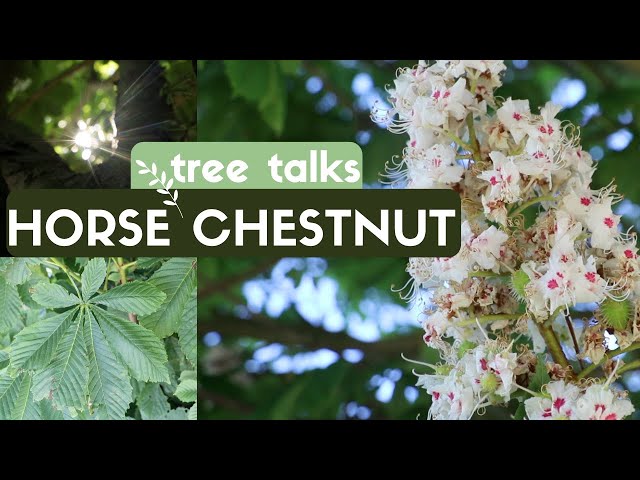The horse chestnut tree, scientifically known as Aesculus hippocastanum, is a deciduous tree native to parts of Southeast Europe and West Asia. It is a popular ornamental tree known for its distinctive appearance, large, palmately compound leaves, and showy, cone-like fruit known as conkers. Here are some key identification and facts about the horse chestnut tree:
Identification:
- Leaves: Horse chestnut leaves are palmately compound, consisting of five to seven individual leaflets. Each leaflet is elliptical with serrated margins and measures several inches in length.
- Bark: The bark is gray-brown and develops furrows and ridges with age.
- Flowers: In late spring to early summer, the tree produces large, upright clusters of white or pale pink, fragrant, and showy flowers. Each flower has a distinctive shape with a yellow blotch at the base.
- Fruit: The fruit of the horse chestnut is known as a conker. Conkers are spiky, green husks that contain one or two large, shiny brown seeds. The seeds are toxic when raw but are sometimes used in traditional games or for crafts after they are processed and dried.
- Size: Horse chestnut trees can reach a height of 50-80 feet (15-25 meters) and have a rounded to pyramidal shape.
Facts:
- Ornamental Tree: Horse chestnut trees are commonly planted for their attractive foliage, spring flowers, and conkers. They are often found in parks, gardens, and along streets.
- Toxicity: The seeds (conkers) and leaves of the horse chestnut tree contain toxic compounds, particularly aesculin. Ingesting these parts can lead to various health issues, so they should not be consumed. The horse chestnut is not the same as the edible chestnut tree (Castanea) that produces edible chestnuts.
- Pests and Diseases: Horse chestnut trees can be susceptible to various pests and diseases, including leaf-mining moths and canker diseases. These issues can affect the tree’s health and appearance.
- Habitat: Horse chestnut trees prefer well-drained soil and thrive in temperate climates. They can tolerate both full sun and partial shade.
- Historical Uses: Historically, horse chestnuts were used in traditional medicine to treat various ailments. However, their use is not recommended due to their toxicity.
- Cultural Significance: In the UK and other parts of Europe, conkers from the horse chestnut tree have been used in traditional games and contests. The “conkers” game involves players trying to break each other’s conkers by taking turns to strike them with their own conker.
- Conservation Status: In some regions, horse chestnut trees have been affected by pests and diseases, such as the horse chestnut leaf miner and the bacterium Pseudomonas syringae. These issues have raised concerns about the health and conservation of these trees.
Horse chestnut trees are appreciated for their aesthetic qualities, but their toxic seeds and susceptibility to various issues require careful management when planted in urban and natural environments.
The tree typically grows to a height of about 20-40 feet, with a spread of about 20-30 feet, and has an upright oval shape. The Horse Chestnut Tree has dark green leaves that are serrated on the edges and grow in pairs along the branch. The Horse Chestnut Tree produces clusters of small white flowers in late spring that turn into yellow-green fruits in September to October.
The Horse Chestnut Tree is not an endangered species but it is susceptible to pests, such as the chestnut blight fungus, which causes cankers on branches and twigs, which can lead to branch dieback or even death of the tree if left untreated for too long.










